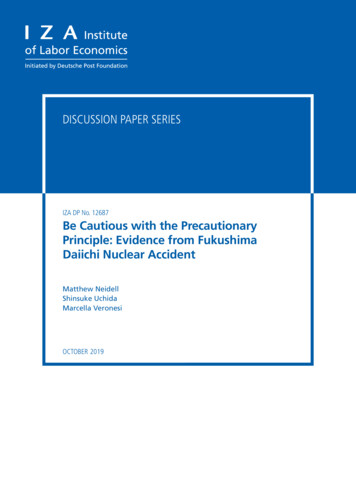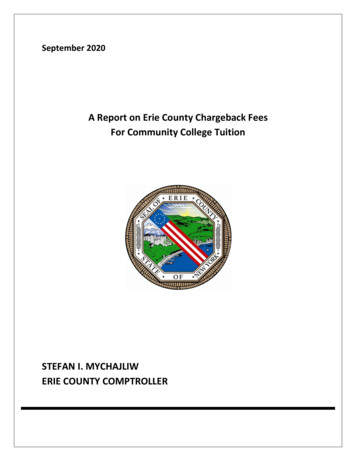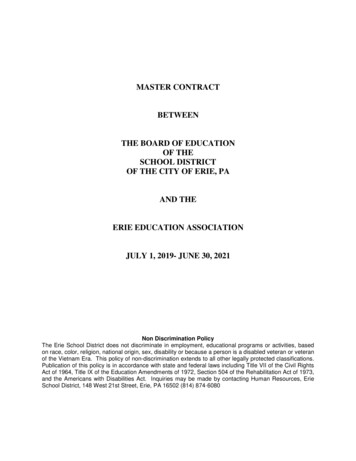
Transcription
DISCUSSION PAPER SERIESIZA DP No. 12687Be Cautious with the PrecautionaryPrinciple: Evidence from FukushimaDaiichi Nuclear AccidentMatthew NeidellShinsuke UchidaMarcella VeronesiOCTOBER 2019
DISCUSSION PAPER SERIESIZA DP No. 12687Be Cautious with the PrecautionaryPrinciple: Evidence from FukushimaDaiichi Nuclear AccidentMatthew NeidellColumbia University, IZA and NBERShinsuke UchidaGSE, Nagoya City UniversityMarcella VeronesiUniversity of Verona, NADEL and ETH ZurichOCTOBER 2019Any opinions expressed in this paper are those of the author(s) and not those of IZA. Research published in this series mayinclude views on policy, but IZA takes no institutional policy positions. The IZA research network is committed to the IZAGuiding Principles of Research Integrity.The IZA Institute of Labor Economics is an independent economic research institute that conducts research in labor economicsand offers evidence-based policy advice on labor market issues. Supported by the Deutsche Post Foundation, IZA runs theworld’s largest network of economists, whose research aims to provide answers to the global labor market challenges of ourtime. Our key objective is to build bridges between academic research, policymakers and society.IZA Discussion Papers often represent preliminary work and are circulated to encourage discussion. Citation of such a papershould account for its provisional character. A revised version may be available directly from the author.ISSN: 2365-9793IZA – Institute of Labor EconomicsSchaumburg-Lippe-Straße 5–953113 Bonn, GermanyPhone: 49-228-3894-0Email: publications@iza.orgwww.iza.org
IZA DP No. 12687OCTOBER 2019ABSTRACTBe Cautious with the PrecautionaryPrinciple: Evidence from FukushimaDaiichi Nuclear Accident*This paper provides a large scale, empirical evaluation of unintended effects from invokingthe precautionary principle after the Fukushima Daiichi nuclear accident. After the accident,all nuclear power stations ceased operation and nuclear power was replaced by fossilfuels, causing an exogenous increase in electricity prices. This increase led to a reduction inenergy consumption, which caused an increase in mortality during very cold temperatures.We estimate that the increase in mortality from higher electricity prices outnumbers themortality from the accident itself, suggesting the decision to cease nuclear production hascontributed to more deaths than the accident itself.JEL Classification:I12, K32, Q41Keywords:precuationary principle, nuclear energy, electricity, mortalityCorresponding author:Matthew NeidellDepartment of Health Policy and ManagementMailman School of Public HealthColumbia University722 W. 168th St.New York NY 10032USAE-mail: mn2191@columbia.edu* We thank Michele Baggio, Geoffrey Barrows, Francois Cohen, Olivier Deschenes, Tatyana Deryugina, LucijaMuehlenbachs, Peter Martinsson, Jisung Park, Alberto Salvo, Reed Walker, and Hendrik Wolff for their suggestions.The authors would also like to thank for their comments participants at the 6th IZA Workshop on “Environmentand Labor Market,” 6th World Congress of Environmental and Resource Economists, Workshop on “Environment &Health: An Economic Perspective” at the Ecole Normale Supérieure Paris-Saclay, Cachan, 6th IAERE Conference, 23rdAnnual Meeting of the Society of Environmental Economics and Policy Studies, and seminar participants at AmericanUniversity, Asian Development Bank, Hitotsubashi University, Nagoya City University, the Shinshu University, andUniversity of Verona. This paper was previously circulating with the title “Extreme Weather Events, Mortality, andEnergy Prices: A Natural Experiment from Japan.” All errors and omissions are our own responsibility. The researchreported in this paper is not the result of a for-pay consulting relationship. Our employers do not have a financialinterest in the topic of the paper which might constitute a conflict of interest. We acknowledge data support fromthe Ministry of Health, Labor and Welfare of Japan that provided mortality counts by cause and age class upon specialtabulation request. We also acknowledge financial support from Japan Society for the Promotion of Science, MurataScience Foundation, Shikishima Research and Cultural Foundation.
As a regulatory tool, the precautionary principle has been met with mixed reactions.While many variants exist, a generally accepted definition of the principle is that activitiesshould not proceed when the threats of damage are not fully understood.1 A major concern withthis principle is that by focusing solely on the risk from action, it fails to consider the risk fromthe alternative action. Something abandoned out of precaution is replaced by something else,which may also carry risk. From an economic perspective, it fails to consider the tradeoffsinherent in policy decisions.In this paper, we provide a large scale, empirical evaluation of the tradeoff from invokingthe precautionary principle using the nuclear power plant shutdowns resulting from the accidentat Fukushima, Japan.2 The accident, which resulted from a Tsunami caused by the 4th largestearthquake in recorded history, led to a nuclear meltdown at the Fukushima Daiichi nuclearpower plant. Driven by long-standing concerns over the unknown effects from radiation risk, thisrejuvenated the anti-nuclear movement.3 Within 14 months of the accident, nuclear powerproduction came to a complete halt in Japan.4The decrease in nuclear energy production did not come without a cost: higher electricityprices. To meet electricity demands, the reduction in nuclear energy production was offset byincreased importation of fossil fuels, which increased the price of electricity by as much as 38percent in some regions. These higher electricity prices led to a decrease in electricity1E.g., World Charter for Nature (1983); Rio Declaration on Environment and Development (1992, principle 15).While there are several case studies that evaluate this tradeoff (see, for example, those described in Adler 2000;Sunstein 2003), we are unaware, to the best of our knowledge, of large scale, systematic evidence.3While there may be many reasons behind the anti-nuclear movement, nearly all are rooted in the precautionaryprinciple. The main damages from nuclear power include risk from an accident, risk from nuclear waste and routineradioactive releases, all of which raise concerns with risks from radiation exposure. Additional concerns includeincreased nuclear proliferation and threats of terrorism, both of which also relate to unknown risks and damages, andthus relate to the precautionary principle.4The accident also triggered opposition to nuclear production around the globe, with several nations ceasing nuclearoperations shortly after the Fukushima accident.22
consumption, particularly during times of the year with greater heating demand. Given the rolethat climate control plays in providing protection from extreme weather events, we find that thereduced electricity consumption caused an increase in mortality. Our estimated increase inmortality from higher electricity prices significantly outweighs the mortality from the accidentitself, suggesting the decision to cease nuclear production caused more harm than good.We produce these results using the following strategy. First, we document that theshutdown of nuclear power plants increased electricity prices, with strong variation throughoutthe country depending on the initial energy mix within a region. For example, regions withalmost no nuclear energy before the accident experienced electricity prices increases around 10percent, whereas regions with higher dependence on nuclear experienced prices increases up to40 percent. The highly regulated nature of residential electricity markets in Japan means thatsupply factors contributed to these price changes, suggesting the price changes are exogenous toconsumer demand for electricity.Second, we explore how the price changes affected electricity consumption, estimatingmodels that include multiple fixed effects to control for many possible sources of confounding.For example, in our richest specification we compare electricity consumption in Tokyo inJanuary, 2012 to electricity consumption in Tokyo in January, 2011. We find that electricityconsumption decreased roughly 1-2 months after price changes occur, a finding consistent withmodels of rational inattention (e.g., Salee 2013, Auffhammer and Rubin 2018). The decreases inelectricity consumption are more pronounced during the winter5, suggesting less protectionduring the coldest times of the year.5Most sources of heating and cooling in Japan rely on energy from the grid except for Northern Japan.3
Third, we explore the consequences from the reduced electricity consumption byestimating how it moderates the temperature-mortality relationship. We estimate fixed effectmodels with flexible temperature bins to relate exogenous changes in monthly temperature tomortality. Similar to previous research, we find that extreme temperatures affect mortality (e.g.,Deschenes and Moretti 2009, Deschenes and Greenstone 2011, Barreca et al. 2016, Karlsson andZiebarth 2018), in particular during very cold temperatures, though the effects from highertemperatures are small given high rates of air conditioning penetration, comparable to morerecent estimates in the US. We then interact temperature with electricity prices to explore howelectricity prices moderate the relationship between temperature and mortality. We findincreased mortality effects from extreme cold weather, suggesting the decreased consumption ofelectricity that resulted from higher electricity prices increased mortality.6 Our findings arerobust to a wide variety of specification tests.To put these estimates in context, we calculate that the higher electricity prices resulted inat least an additional 1,280 deaths during 2011-2014. Since our data only covers the 21 largestcities in Japan, which represents 28 percent of the total population, the total effects for the entirenation are even larger. Meanwhile, the number of deaths due to the Fukushima Daiichi nuclearaccident is much lower. No deaths have yet to be directly attributable to radiation exposure,though projections estimate a cumulative 130 deaths (Ten Hoeve and Jacobson 2012). Anestimated 1,232 deaths occurred as a result of the evacuation after the accident.7 Therefore, thedeaths from the higher electricity prices likely outnumber the deaths from the accident in only6This finding is consistent with the evidence from Chirakijja et al. (2019), who find that lower energy prices in theUS as a result of natural gas expansion decreased mortality rates, and Bhattacharya et al. (2003), who find that coldshocks lead to decreased nutrition.7These estimates we gathered from interviews conducted in local municipalities in Fukushima in March 2015 by theTokyo Shimbun Newspaper (Tokyo Shimbun 2016).4
four years if we extrapolate our estimates to the entire country, and almost certainly outnumberthe deaths over a longer time period given that the higher electricity prices persisted beyond theend of our study. This suggests that ceasing nuclear energy production has contributed to moredeaths than the accident itself.Electricity markets in JapanFor the period of our analysis, 2007-2014, the electricity market in Japan was heavilyregulated.8 The market consisted of ten regions (Figure 1). In each region, there was only oneelectric power company where households can purchase their electricity. Household electricitybills consist of nonlinear price schedules: a basic delivery charge and 3-tier energy charges basedon consumption in the previous month (1-120kWh, 121-300kWh and over 300kWh).9 To changethe rate of the basic charge and/or 3-tier energy charges for residential electricity, electricitycompanies were required to apply to the Ministry of Economy, Trade and Industry (METI) forpermission. Any request for a price change must relate to the electric power company’s operatingcosts, the level of investment, and the dependence on fossil-fuel based power generation (coal,liquefied natural gas, and oil).As shown in Figure 2, prices were relatively steady and quite comparable across theregions before the Fukushima accident in 2011. In fact, during this time, applications for a pricechange were approved almost simultaneously for the ten electricity companies. Between 20078The residential electricity market in Japan has been deregulated since April 2016.Six regions (Hokkaido, Tohoku, Tokyo, Hokuriku, Chubu and Kyushu) and the remaining four regions (Kansai,Chugoku, Shikoku and Okinawa) have slightly different pricing systems; the first group of regions applies themonthly basic charge per 10A and the latter a minimum charge of 1-15kWh.95
and 2011, each region underwent just one approved price change (in 2008), due to the surge inworld oil prices.10Shortly after the Fukushima disaster, all nuclear power reactors ceased production inJapan.11 Shortage of power generation from these shutdowns was mostly offset by increasing theimportation of fossil fuels. The electricity power companies resumed operations of old, often idlecoal, gas, and oil-fired power generators to convert the fuel into energy. The share of powergeneration from fossil fuels rose from 62 to 88 percent in the four years after the earthquake,while the share of nuclear power generation declined from over 30 percent to zero (U.S. EnergyInformation Administration, 2015). This led to significant increases in energy prices.Furthermore, the dependence on nuclear power prior to Fukushima varied acrossregions, ranging from zero to 44 percent. Therefore, the replacement of nuclear power with fossilfuels also differed regionally after the shutdowns (Table 1). This resulted in a non-uniformincrease in electricity prices across regions after 2011 (Figure 2).12The size of the increase in electricity prices depended on the initial proportion ofnuclear-powered generation as well as the choice of how to replace it. As shown in Figure 2,some regions (e.g., Hokkaido, Kansai, and Tokyo) underwent a sharp increase in electricityprices while other regions (e.g., Chugoku and Okinawa) experienced a smaller increase. Forinstance, comparing the average price index of residential electricity in January 2011 andDecember 2014, there was an increase of 33 percent in the Hokkaido region, 29 percent in the10Changes in imported oil prices explain the smaller price shifts across years in Figure 2.At the time of the Fukushima accident, 37 of the 54 reactors were in operation (The Independent InvestigationCommission on the Fukushima Nuclear Accident 2014). After the accident, all reactors were shutdown until onereactor, in Kyushu, was allowed to restart in August 2015.12In addition, the oil price peaked at more than 100/barrel in 2012 due to political instability in the Middle East (Iran,Syria, Egypt, Libya, and Iraq). In general, per unit, the operation cost of coal/gas/oil-fired power stations is muchhigher than in nuclear power stations, so the net effect of the replacement of nuclear by fossil fuels is negative.According to METI (2015), the average annual cost of replacement was about 3.1 trillion yen (0.65 percent of GDP)in 2011-2014.116
Kansai region, and 38 percent in the Tokyo region. Table 1 shows that, before 2011, the energydependence of these three regions on nuclear power was considerable (44 percent in Hokkaidoand Kansai; 28 percent in Tokyo). In contrast, the price schedule did not increase as much in theChugoku and Okinawa regions (15 percent and 14 percent, respectively) where the share ofelectricity generated by nuclear power stations was very small before 2011 (three percent inChugoku and zero in Okinawa).13 We exploit this regional variation in prices over time toidentify the causal effects of interest.DataWe collected monthly data in the 21 largest municipalities in Japan from 2007 to 2014 onresidential electricity prices, electricity expenditure, mortality rates, population, and weather.The 21 largest municipalities consist of the special wards of Tokyo and 20 so-called “designatedcities” (see Figure A1 of the Appendix). A municipality with a population greater than 500,000can be designated by government ordinance. These cities are located in seven of the tenelectricity regions: Hokkaido, Tohoku, Tokyo, Chubu, Kansai, Chugoku, and Kyushu. Themonthly average price (per kWh) of electricity, obtained from the Japanese statistical office, iscomputed as the weighted average of the unit price paid by five groups of households in eachregion, where the groups are defined by the consumption level and contract.14A. Residential Electricity Price Data13The price schedule in Hokuriku and Shikoku regions did not increase much despite high nuclear dependence. Thisis because of a smaller population (and industrial size) than other regions that required a smaller production of theabsolute amount of electricity. Also, they replaced nuclear mostly by coal, which was relatively cheap. Hokkaido,on the other hand, experienced higher price increase than Shikoku despite having similar nuclear dependence andeconomy size. This arose from greater dependence on oil, which was more expensive than coal, after the shutdown.14The five groups are those who consume 160kWh electricity per month with a 20A contract, 250kWh (30A),330kWh (40A), 440kWh (50A), and 720kWh (60A). The number of households in each group is used as a weight.7
Monthly residential electricity prices are obtained from the Retail Price Statistics Survey by theMinistry of Internal Affairs and Communications of Japan. Given the regulated nature ofelectricity markets, these prices are uniform for cities within the same electricity region.B. Electricity expenditureGiven the lack of access to electricity consumption data we instead collected publiclyavailable data on household electricity expenditure at the municipality level. These data areobtained from the Ministry of Internal Affairs and Communications, which conducts a monthlysurvey to collect information from sample households regarding monthly household expenditureon various goods including electricity. Households are randomly selected from the stratifiedcensus in each municipality, and asked to record their expenditures for six consecutive months.In each month, one-sixth of the sample households are replaced by new observations. Becausethe collected number of single-member households is very limited at the municipality level, dataare only available for the subgroup of households with two or more members. This monthlyaverage electricity expenditure is then used to examine electricity consumption by estimating theprice elasticity of demand in the 21 cities during our sample period.It is important to note that the vast majority of heating and cooling devices in Japan relyon electricity for power. For example, air conditioners, which rely on grid electricity, are theprimary source of both cooling and heating, which differs from places like the US. Kerosene andgas stoves are used at much lower rates, though they are more prevalent in the northern regionsof Hokkaido and Tohoku. As a robustness check, we estimate models that exclude these tworegions (Sapporo, Sendai, and Niigata cities).8
C. Mortality and Population DataMonthly mortality data at the municipality level are from the Survey on PopulationDynamics by the Ministry of Health, Labor and Welfare of Japan. Mortality data are combinedwith age-specific city population data to compute age-adjusted mortality rates (per 100,000population). The annual population of the designated cities by age groups is available from theStatistics Bureau of the Ministry of Internal Affairs and Communications. We also useinformation on cause of mortality to evaluate the robustness of our results.D. Weather DataWe use hourly weather information from the Meteorological Agency of Japan. All butfive designated cities have weather stations in the city center. For those five cities (Kawasaki,Kitakyushu, Saitama, Sagamihara, and Sakai) data are replaced by the nearest stations inneighboring municipalities (ranging from 9 to 28 km away). A key variable for our analysis ishourly average temperature. We follow Deschenes and Greenstone (2011) and Barreca et al.(2016) to construct temperature bins to approximate the distribution of temperatures. Figure 3illustrates the annual average distribution of hourly average temperature over eight temperaturebins ( 0, 0-4, 5-9, 10-14, 15-19, 20-24, 25-29, 30 C). Each bar represents the weighted averagenumber of hours per year in each temperature bin, using the total population in a city-year asweights. Table 2 shows the annual average mortality rates and temperature distributions byregion. Regional variations in hourly temperature are mainly observed in both tails of thetemperature distribution.Other meteorological elements and air pollution are potential confounders in therelationship between temperature and mortality. To address this, we also collected data on9
precipitation and average wind speed from the Japanese Meteorological Agency, and airpollution data (Suspended Particulate Matter, SPM; Photochemical Oxidant, Ox) from theNational Institute for Environmental Studies.Econometric ModelsIn this section, we describe the two econometric models we estimate. First, we estimatethe effect of electricity prices on consumption. Second, we estimate the effect of temperature onmortality, and explore whether energy prices shift this relationship.A. Electricity prices and demandTo explore the relationship between residential electricity prices and electricity demand,we follow the empirical model developed by Auffhammer and Rubin (2018). Specifically, weestimate the following equation:(1) log(EXPct) δlog(Pct-k) Xctβ ρct εctwhere EXPct is the average household expenditure of electricity in city c and month t, and Pct-k isthe average residential electricity price in month t-k. The parameter of interest is (δ-1), whichrepresents the price elasticity of residential electricity demand.15 As previously discussed, theregulated electricity market dictates that price changes are driven solely by supply-side factors,suggesting price changes are exogenous to demand-side factors, enabling identification of the15Recall that we only observe electricity expenditure data. Since 𝑙𝑛𝐸𝑋𝑃𝑐𝑡 𝑙𝑛𝑝𝑐𝑡 𝑙𝑛𝑞𝑐𝑡 𝑙𝑛𝑝𝑐𝑡 1, the price elasticity is 𝑙𝑛𝑞𝑐𝑡 𝑙𝑛𝑝𝑐𝑡 𝛿 1.10
parameter δ. Based on the law of demand, we hypothesize that higher electricity prices reducesenergy consumption (δ-1 0) (hypothesis 1).Although energy prices change monthly, consumers may not respond immediately toprice changes because of rational inattention (Salee 2013, Auffhammer and Rubin 2018). Forexample, households in Japan usually learn about residential electricity prices when they receivetheir electricity bill, which specifies the price during the previous period (i.e., the first price lag).The bill of the previous month arrives about ten days into the current billing period, withpayment due within two weeks for automatic billing and within 30 days for cash payments.Given this billing structure, household decisions about electricity consumption may respond toelectricity prices with a lag, as evidence within the US supports (Auffhammer and Rubin 2018).Therefore, we allow for a possible delayed effect of price changes on consumption by allowingprice to enter equation (1) with a lag as denoted by t-k, where k {0, 1, 2}. We also use theaverage price rather than the marginal price given previous evidence that suggests thatconsumers respond to the average electricity price and not to the marginal price because of thecognitive burden of understanding complex pricing (e.g., Shin 1985; Metcalf and Hassett 1999;Bushnell and Mansur 2005; Borenstein 2009; Ito 2014).To control for other factors that may explain energy consumption, we include severaladditional variables in this model. The variable Xct includes several time-varying covariates.First, we control for weather flexibly as the number of hours in city c and month t where hourlytemperature is categorized in one of the seven temperature bins i 0, 0-4, 5-9, 10-14, 20-24, 2529, 30 degrees Celsius (the 15-19 degrees Celsius bin is the excluded category). Second, wecontrol for unusually low or high precipitations by using two dummy variables equal to one ifmonthly precipitation is less than the 25th or more than the 75th percentile of the 2007-201411
average monthly precipitation in a given city-month, respectively. Third, we include a vector ofhousehold characteristics, such as the total number of household members, the percentage ofchildren under 18 years of age, the percentage of the elderly (65 or above), the percentage ofadults with a job, the age of the household head, the logarithm of total household expenditure,the percentage of home ownership, the size of the house, and the percentage of farm households.Fourth, we account for the destruction and reconstruction of power-supply lines in Sendai afterthe earthquake by including a dummy variable equal to one for Sendai city in March 2011.This model also includes several fixed effects to account for various fixedcharacteristics, denoted by the term ρct. We include city-by-month fixed effects to account forseasonality in electricity use by city, and year-by-month fixed effects to control for time-varyingfactors common to all cities (e.g., macro business cycles, national policies such as governmentinformation policy on energy use). We also account for the change in the awareness of energysaving behavior after the earthquake by including city-by-period fixed effects, where the periodis defined equal to one after the March 2011 earthquake and zero before then. After theFukushima accident, energy-saving campaigns were conducted at both national and region/citylevels for several years. As a result, some households reduced electricity consumption and othersreplaced heating and cooling devices with more energy-efficient appliances regardless of thechange in the electricity price. Finally, standard errors are clustered at the city level, andregressions are weighted by the number of households within a city.B. Temperature and mortalityAfter exploring the relationship between energy prices and consumption, we next turn tohow this affects the temperature-mortality relationship. We begin by estimating the temperature12
mortality relationship, adhering to the specification by Barreca et al. (2016). Specifically, weestimate the following equation:(2) log(Mct) ΣiαiTcti Xctθ γct μct.In this equation, Mct is the monthly mortality rate (per 100,000) in city c and month t. Asspecified in Barreca et al. (2016), Tcti represents temperature values over the past two months toaccount for lagged physiological effects, with hourly temperature indicators as discussed above.Based on previous findings, we expect extreme temperatures to increase mortality (hypothesis2).The vector Xct includes controls for precipitation as defined above and a dummy variablefor the excess mortality from the earthquake and tsunami in Sendai city in March, 2011. A seriesof fixed effects are included in the vector γct, which includes city-by-year to adjust forunobservable city-specific, dynamic determinants of mortality rates (e.g., age distribution,income distribution, and hospital quality),16 year-by-month to control for time factors common toall the cities (e.g., national business cycles), and city-by-month fixed effects to account forunobservable city-specific, seasonal factors that may affect mortality (e.g., migration, seasonalemployment, and epidemics such as influenza). Regressions are weighted by city-levelpopulation, and standard errors are clustered by city.This model fits temperature semi-parametrically, with the only assumption that theimpact of hourly temperature on the monthly mortality rate is constant within five-degree Celsius16In this equation, we can include city-by-year (instead of city-by-period) fixed effects because there is considerablevariation in temperature within cities over time, unlike electricity prices, which move slowly over time (see Figure2).13
intervals. Our use of fixed effects allows us to identify the causal effect of temperature onmortality rates by relying on random variations in the temperature distribution for a given cityand month. This model builds on existing models of temperature and mortality (Deschenes andGreenstone 2011; Barreca et al. 2016) and the climate-economy literature more generally (Dell etal. 2014). An important deviation in our model is that we include hourly temperature to avoidhaving to distinguish between maximum, mean, and minimum temperatures.C. Electricity prices, temperature and mortalityAfter exploring the dose-response relationship between temperature and mortality, wethen investigate the effect of residential electricity prices on the temperature-mortalityrelationship. This model extends equation (2) by adding the residential electricity price and itsinteraction with temperature. Specifically, we estimate the following equation:(3) log(Mct) Σiα’iTcti δ’log(Pct-k) ΣiλiTcti*log(Pct-k) Xctθ’ γ’ct vct.where all variables are defined as in equations (1) and (2), with the prime superscript separatingthis equation from the previous one. Our main focus is on the interaction term of the temperaturebins and lagged price, λ, which indicates whether price moderates the effect of temperature onmortality. Based on hypotheses 1 and 2 above, we hypothesize that mortality rates increase withthe rise of the electricity price during extreme temperatures (λ 0) (hypothesis 3). That is, ifhigher electricity prices reduce the usage of heating and cooling devices, this increases exposureto extreme temperatures, and therefore the risk of dying. This is a strong hypothesis because weonly expect the
We estimate that the increase in mortality from higher electricity prices outnumbers the mortality from the accident itself, suggesting the decision to cease nuclear production has contributed to more deaths than the accident itself. JEL Classification: I12, K32, Q41 Keywords: precuationary principle, nuclear energy, electricity, mortality










